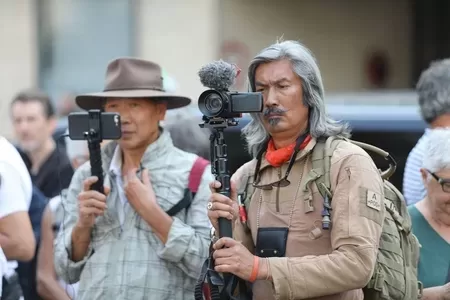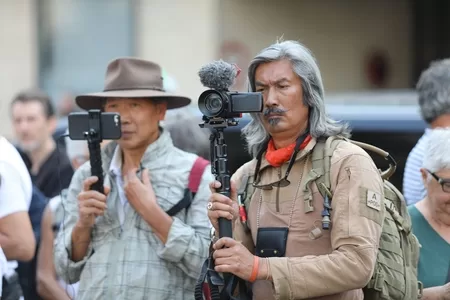After a decade of massive change, the 1990s ended with the world passing through the Millennial, and Getty Images storming the scene, disrupting the stock photo industry dominated by AP, Reuters, AAP and other agencies. Australian celebrity photographer Patrick Riviere joined Getty as Entertainment Photos.
The Evolution of Stock Photography: How Getty Images and Disruptors Changed the Game
Join us as we explore the history and impact of Getty Images and other similar disruptors, and examine the ripple effects they’ve had on traditional media outlets, including the closing of magazines and the sacking of newspaper photographers.
The Birth of Stock Photography: The concept of stock photography can be traced back to the mid-20th century when agencies began compiling collections of images for commercial use. These early stock photo libraries primarily served advertisers, publishers, and designers seeking high-quality visuals to complement their content. However, it wasn’t until the digital revolution of the late 20th century that stock photography truly came into its own.


Getty Images: A Game-Changer in the Industry: Getty Images, founded in 1995 by Mark Getty and Jonathan Klein, quickly emerged as a dominant force in the stock photography market. Leveraging the power of the internet and digital technology, Getty Images revolutionized the way images were licensed and distributed, offering a vast catalog of high-quality photos, illustrations, and videos to clients around the globe. With strategic acquisitions and partnerships, Getty Images solidified its position as the go-to source for visual content, setting the stage for a new era in the industry.
Disrupting Traditional Models: The rise of Getty Images and other similar disruptors challenged traditional models of photography licensing and distribution. By offering a centralized platform for photographers to showcase their work and clients to license images quickly and easily, these agencies democratized access to visual content, bypassing traditional intermediaries and empowering photographers to reach a global audience.
In the ever-changing landscape of visual media, few developments have been as transformative as the rise of stock photography agencies like Getty Images. From their humble beginnings to their current dominance in the industry, these disruptors have reshaped the way we access and use images, with profound implications for photographers, media outlets, and creative professionals worldwide.
Impact on Traditional Media Outlets: The widespread availability of high-quality stock photography had a profound impact on traditional media outlets, including magazines and newspapers. With the rise of digital publishing and the proliferation of online platforms, many publications faced pressure to cut costs and streamline operations. As a result, some magazines shuttered their doors, while others reduced their reliance on in-house photographers in favor of cheaper stock imagery.
The Decline of Newspaper Photographers: Similarly, newspapers, long a bastion of photojournalism, grappled with declining revenues and shifting consumer preferences. In an effort to cut costs and adapt to digital trends, many newspapers laid off staff photographers and turned to stock imagery or freelance contributors to fill their visual needs. This shift not only impacted the livelihoods of seasoned professionals but also raised questions about the future of photojournalism and the integrity of news reporting.
The Rise of User-Generated Content: In recent years, another disruptive force has emerged in the form of user-generated content platforms like Unsplash and Shutterstock. These platforms allow individuals to upload and share their photos and videos with the world, often for free or at a minimal cost. While these platforms offer unprecedented access to a vast array of visual content, they also raise concerns about copyright infringement, fair compensation for creators, and the devaluation of professional photography.
Looking Ahead: As we look to the future, the impact of Getty Images and other disruptors on the photography industry continues to reverberate. While these platforms have democratized access to visual content and empowered photographers to showcase their work on a global scale, they have also disrupted traditional models of photography licensing and distribution, leading to the closure of magazines, the downsizing of newspaper photography staff, and the rise of user-generated content.
The history and impact of Getty Images and other similar disruptors underscore the profound changes taking place in the photography industry. As technology continues to evolve and consumer preferences shift, photographers, media outlets, and creative professionals must adapt to new realities, embracing innovation while preserving the integrity and value of their craft. Only by navigating these challenges with creativity, resilience, and adaptability can we ensure a vibrant and sustainable future for the world of visual media.
Everyone is a Photographer Now
Chapter 1: The Evolution of Photography
Chapter 2: The Rise of Smartphone Photography
Chapter 3: Visual Literacy in the Digital Age
Chapter 4: The Democratization of Artistic Expression
Chapter 5: Professional Photography in the Digital Era
Chapter 6: Vertical integration of traditional media into social media
Conclusion: Navigating the Future of Professional Photography
Related stories
The Future of Work as a Media Worker
Who owns photographs posted on social media
The Kiss in Times Square photograph by Alfred Eisenstaedt cancelled?
Andre Kertesz, a pioneer of street & fine art photography
Sarah Moon, French fashion photographer
Speos Magnum documentary & AFP photojournalism courses
John Bell re-enacts historic Hitler – Hoffman photo session
Dorothea Lange’s Pioneering Approach to Portraiture
The first photograph taken in Australia was by Captain Lucas
Guide to Collecting Vintage Film Cameras
Care to leave a comment below? Want to collaborate? After all, everyone is a photographer now. ChatGPT-assisted as part of a thesis on the future of work as a photographer and the changes to the media industry.






